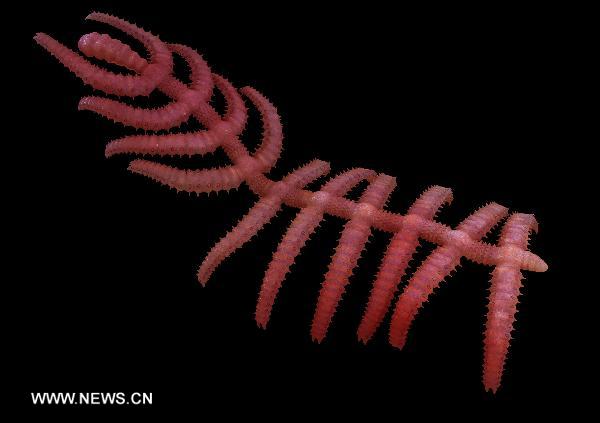
Fossil Find Shows "walking cactus" Is Lost Arthropod Relative
Mar 01, 2011 Email"> PrintText Size


This undated handout, a computer-generated image provided by Chinese scientist Liu Jianni shows the probable appearance of the remarkable 520 million year old fossil Diania cactiformis in life discovered in southwest China's Yunnan Province. The legs are partially jointed and the front of the animal, with the projecting proboscis, is to the left. The research was published on Nature Magazine on Feb. 24. (Xinhua)
Chinese scientists say a "walking cactus" that inhabited the earth more than 500 million years ago might indicate how the jointed legs of insects, spiders and crustaceans evolved.
The fossil of "Diania cactiformis" -- nicknamed the "walking cactus" because of its resemblance to the spiny plant -- was collected from the fossil-rich county of Chengjiang, southwest China's Yunnan Province, in 2006.
Paleontologists from Northwest University in Xi'an, capital of northwest China's Shaanxi Province, believe the animal belongs to the Lobopodia, a poorly understood, now extinct, group of animals that resembled worms with legs.
"It could be seen as a missing link from lobopodians to arthropods," said Dr. Liu Jianni who led the research.
Liu said scientists had long suspected that arthropods evolved from lobopodians, but lacked evidence to prove the hypothesis until the "walking cactus" was found.
Liu's thesis, "An armored Cambrian lobopodian from China with arthropod-like appendages," was published Thursday as the cover story on the latest issue of Nature.
The fossil, which dates from 500 million years ago, is about 6 cm long. It resembles a thin, soft-bodied worm, similar to the lobopodians. But its 10 pairs of jointed legs also resemble those of arthropods.
Liu and her colleagues believe these legs had hardened surfaces, probably similar to the tough surfaces of the articulated limbs of crustaceans or insects.
The finding could indicate that arthropods developed hardened limbs before hardened bodies, the researchers say.
Liu said the development of jointed legs was only one of the three critical steps in the evolution of arthropods from lobopodians. She and her colleagues hope to find further lobopodia fossils that show the development of both the arthropod head and jointed body.
"With these appendages, arthropods were able to run faster, jump higher and move with more agility. Some appendages even evolved into preying instruments," said Prof. Shu Degan, head of Northwest University's Early Life Institute. "They helped arthropods become powerful and eventually dominant members of marine, freshwater, land and air ecosystems."
Arthropods comprise more than 80 percent of all known living animal species, and make up the bulk of the tree of life.
Besides insects, spiders and crustaceans, arthropods also include the now-extinct trilobites. (Xinhua)
 |
| This undated handout, a computer-generated image provided by Chinese scientist Liu Jianni shows the probable appearance of the remarkable 520 million year old fossil Diania cactiformis in life discovered in southwest China's Yunnan Province. The legs are partially jointed and the front of the animal, with the projecting proboscis, is to the left. The research was published on Nature Magazine on Feb. 24. (Xinhua) |
Paleontologists from Northwest University in Xi'an, capital of northwest China's Shaanxi Province, believe the animal belongs to the Lobopodia, a poorly understood, now extinct, group of animals that resembled worms with legs.
"It could be seen as a missing link from lobopodians to arthropods," said Dr. Liu Jianni who led the research.
Liu said scientists had long suspected that arthropods evolved from lobopodians, but lacked evidence to prove the hypothesis until the "walking cactus" was found.
Liu's thesis, "An armored Cambrian lobopodian from China with arthropod-like appendages," was published Thursday as the cover story on the latest issue of Nature.
The fossil, which dates from 500 million years ago, is about 6 cm long. It resembles a thin, soft-bodied worm, similar to the lobopodians. But its 10 pairs of jointed legs also resemble those of arthropods.
Liu and her colleagues believe these legs had hardened surfaces, probably similar to the tough surfaces of the articulated limbs of crustaceans or insects.
The finding could indicate that arthropods developed hardened limbs before hardened bodies, the researchers say.
Liu said the development of jointed legs was only one of the three critical steps in the evolution of arthropods from lobopodians. She and her colleagues hope to find further lobopodia fossils that show the development of both the arthropod head and jointed body.
"With these appendages, arthropods were able to run faster, jump higher and move with more agility. Some appendages even evolved into preying instruments," said Prof. Shu Degan, head of Northwest University's Early Life Institute. "They helped arthropods become powerful and eventually dominant members of marine, freshwater, land and air ecosystems."
Arthropods comprise more than 80 percent of all known living animal species, and make up the bulk of the tree of life.
Besides insects, spiders and crustaceans, arthropods also include the now-extinct trilobites. (Xinhua)
CAS Institutes
There are 124 Institutions directly under the CAS by the end of 2012, with 104 research institutes, five universities & supporting organizations, 12 management organizations that consist of the headquarters and branches, and three other units. Moreover, there are 25 legal entities affiliated and 22 CAS invested holding enterprisesThere are 124 I...>> more
Contact Us

Chinese Academy of Sciences
Add: 52 Sanlihe Rd., Xicheng District, Beijing, China
Postcode: 100864
Tel: 86-10-68597592 (day) 86-10-68597289 (night)
Fax: 86-10-68511095 (day) 86-10-68512458 (night)
E-mail: cas_en@cas.cn

